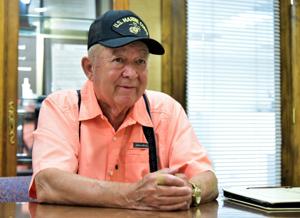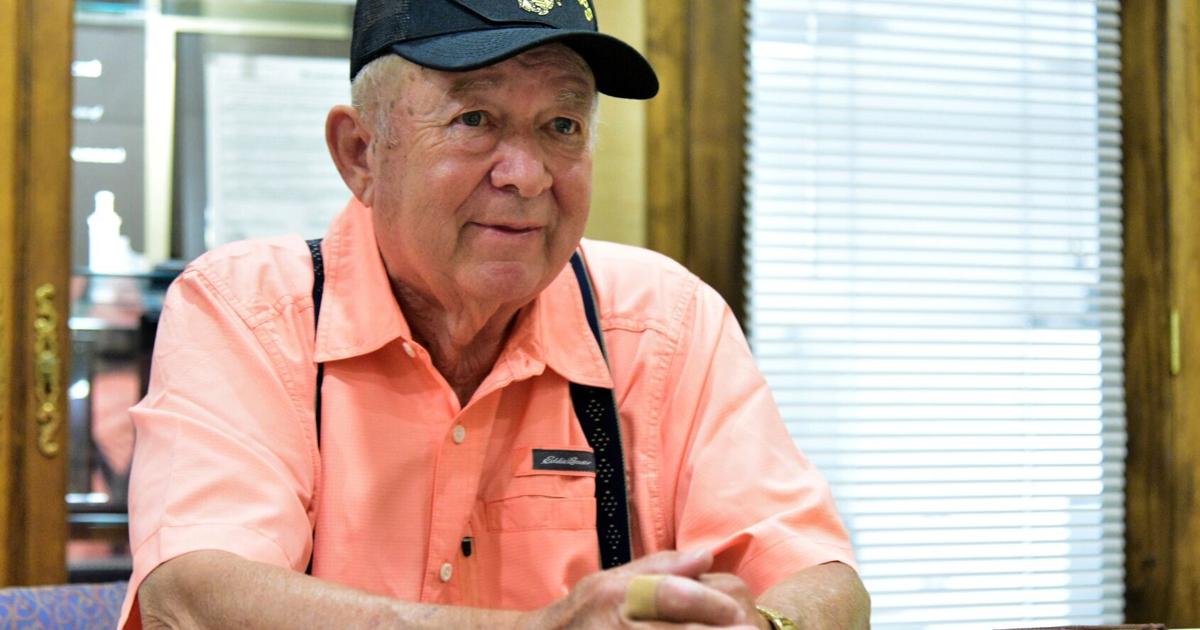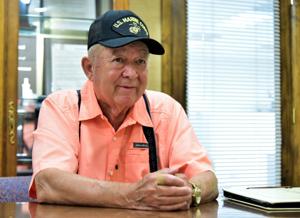

Thomas M. Fogle Sr. recalls having to machete his way through the thick jungle, not ever knowing what mortar round, land mine or even wild animal was ahead of him. It was part of the intensely stressful environment he was in during his year-long service in Vietnam.
The 75-year-old Bolentown resident was drafted into the military in 1968. Fogle chose to follow in the footsteps of his older brother, Bobby, and join the United States Marine Corps.
“It was either serve in the Army or go in the Marine Corps. That’s the only two things I had to decide. I just chose the Marine Corps,” he said.
‘It was very intense’
Fogle would eventually find himself in the throes of battle as a rifleman during the Vietnam War and remembered the intense training it would first take to prepare him for the mission.
The Vietnam War pitted communist North Vietnam and the Viet Cong against South Vietnam and the United States. The war ended when U.S. forces withdrew in 1973 and Vietnam unified under communist control two years later.
People are also reading…
Fogle began his basic training at Parris Island, which has been the site of Marine Corps recruit training since Nov. 1, 1915.
“The discipline and all of that kind of set me back a little bit,” Fogle said, noting that the physical demands of Marine training were no joke.
Combat training at Camp Lejeune, North Carolina, wasn’t any better.
“It was very intense, very strenuous. They sent us through a gas chamber … That was kind of tough. It’s C-4 gas. The marches and the drilling and all of that was very intense,” said Fogle, who also had to learn how to properly board and disembark helicopters and ships.
Then there were the times he had to crawl under barbed wire while under machine gun fire.
“They use live ammunition. … They would just spray the area with live machine gun fire and you had to crawl up underneath it and all that. Nobody would stand up,” he said.
He came home for two weeks from combat training before heading to Camp Pendleton, California, for warfare training.
“That was more of a desert-type environment out there than over on the East Coast. They had villages and everything built up to demonstrate what we were going to face in Vietnam and how to attack these villages and all that,” Fogle said.
It wasn’t long before he received the order to go to Da Nang, a coastal city in central Vietnam known for its sandy beaches and history as a French colonial port.
“I flew into Da Nang about 4 o’clock in the afternoon. This was a big Air Force base where we landed. It was probably about 300 Marines on this one flight. They put us in a Quonset hut. I was in the second Quonset hut, and they told us, ‘In the middle of the night, if you hear a siren go off, you better get out and get in a bunker,’” he said.
The dangers of war were soon upon him.
With his voice breaking, Fogle continued, “Sure enough, about 2 a.m. the sirens started going off, and everybody runs out and gets to their bunker. But the Quonset hut next to mine took a direct hit. Two Marines died.”
The Marine vet said it was tough to lose those two servicemen.
“I didn’t know them, but they were on the same plane and everything coming over there that I was on,” he said.
Fogle had the determination to press forward in spite of loss.
‘My men depended on me’
“Well, you had to just keep on going and keep doing what you were doing and trusting in the Lord. I did a lot of praying. That’s a fact,” he said.
The next day he and the Marines were flown to Dong Ha Air Force Base, which had served as a U.S. Marine Corps and U.S. Army base northwest of Quảng Trị in central Vietnam.
It was there that the truck convoy he joined would soon be hit by enemy fire.
“The truck convoy had to go up to Vandegrift Combat Base … to a place called The Rockpile … They ambushed our truck convoy from the hillside,” he said.
The Rockpile was a jagged mountain rising more than 700 feet from the Cam Lo River bottom. It’s relatively inaccessible location made it an important U.S. Army and Marine Corps observation post and artillery base from 1966 to 1969.
Fogle continued, “The first truck in that convoy hit a landmine and turned over. The road was blocked. They were shooting at us from the hills and everything. The Marine Corps helicopters and gunships came and opened up on their positions, and we got to Vandegrift Combat Base.”
It was one of several brushes with death or injury he would be met with. While he was at the Dong Ha Air Force Base, he recalled the serious injury of a new friend he had just met.
“Everything in the Marine Corps is laid out in structure: Alpha, Bravo, Charlie, Delta is all in a row. My friend, who I just met on that airplane, was going to Hotel Company. My company was Delta, so I got to my company headquarters ahead of him.
“As he turned to go walk on down the line to Hotel Company, a mortar round hit and took his leg off just above the boot. He was medevacked out. I never saw him again. “It’s very real, and, yeah, it wasn’t nothing fun about it,” he said.
Fogle said he nevertheless learned a few lessons, including the value of developing a camaraderie with his fellow service members.
“My men depended on me, and I depended on them. I never did go on any kind of R&R. I just stayed in my unit and did the best I could. When I first got over there, I was with the 4th Marine Division,” he said.
Fogle continued, “After I was with them for like two to 2-1/2 months, the 4th Marine Division pulled out and came back home. I went south to Da Nang. I got with the 1st Marine Division. … I was with India Company, 3rd Battalion, 26th Marines.”
As a rifleman in the infantry unit, most of Fogle’s duties involved search-and-destroy missions.
“Go out on patrols in the daytime, ambushes at night, that kind of stuff. Just every day is the same thing. They are trying to destroy us, and we are trying to destroy them is what it amounts to. I was at a place called Hill 190, and then I was taken over there at a place called Nam O Bridge. Then I went back to Hill 190…. Hill 190 was my platoon base,” Fogle said.
He recalled having to kill an enemy who had infiltrated the ranks at Nam O Bridge.
“We had a barber in our compound. He cut all of the Marines’ hair in there. We were out on an ambush one night. This barber had one leg shorter than the other leg, about four inches. So he had trouble walking and running,” Fogle said.
He continued, “We were out on an ambush one night, and we killed him and two others that night. When we brought them back in our compound, our captain could not believe his eyes. He said, ‘He is in our compound cutting our hair, and he is gathering up information to feed to the Viet Cong.’ As a matter of fact, I think I got a picture of him. You couldn’t trust nobody over there.”
He’s not sure why God let him live through his war experience, but he’s glad he did.
“I don’t know. I mean, he definitely had his hands on me,” said Fogle, who recalled the wet and hostile jungle environment.
“The jungle was thick in there, and you had to machete your way through it. The rice paddies were very hard on us. Wet all the time. The monsoon rains were terrible. I had never seen so much rain in all my life. … I never saw a tiger, but I did see a couple of leopards,” he said.
The return home
He said he and his fellow soldiers did not receive a hero’s welcome when they returned home.
“In California out there was the worst place. When I flew back into Bakersfield, California, to a place called Norton Air Force Base, there were protesters out there by the hundreds. They were throwing tomatoes at us and spitting at us and calling us baby killers and all kind of bad things,” he said.
“It was just more intense out there on the West Coast than anywhere else,” Fogle said, noting that the emotional toll from such treatment could be tough.
When he reflects back on his service, he thinks about whether it was worth the sacrifice.
“Now, today? No, it wasn’t worth it. No. Too many lives were lost. Too many,’ he said, growing emotional.
His posttraumatic stress disorder is among his own residual effects of war. He said that the best part of his experience was leaving Vietnam in 1970 and returning home to his beloved wife, Betsy.
They are the parents of three children, the grandparents of nine and the great-grandparents of six.
“That was the best thing. I was married in ’68. I was married two months before I joined the Marine Corps. She moved in with my parents while I was gone. … I flew into Columbia Airport, and her and my mother and my sister were standing up there. It felt very good,” he said.
Fogle served as a rural carrier for the Orangeburg Post Office for nearly 12 years before health challenges forced him into retirement.
Of his military service, he said it was ultimately important for him to serve his country.
“I think it’s everybody’s duty to support this country and to fight communism and all that. I think that the military is a good organization, especially for young men in teaching them responsibility,” said Fogle, who also appreciated the opportunity to talk about his military experience.
“It means a lot. A lot of this stuff I’ve held in for 40 years, and the PTSD is real. They say it’ll get better over the years, but it’s always in the back of your mind,” he said.
Contact the writer: dgleaton@timesanddemocrat.com or 803-533-5534. Follow “Good News with Gleaton” on Twitter at @DionneTandD
#lee-rev-content { margin:0 -5px; } #lee-rev-content h3 { font-family: inherit!important; font-weight: 700!important; border-left: 8px solid var(–lee-blox-link-color); text-indent: 7px; font-size: 24px!important; line-height: 24px; } #lee-rev-content .rc-provider { font-family: inherit!important; } #lee-rev-content h4 { line-height: 24px!important; font-family: “serif-ds”,Times,”Times New Roman”,serif!important; margin-top: 10px!important; } @media (max-width: 991px) { #lee-rev-content h3 { font-size: 18px!important; line-height: 18px; } } #pu-email-form-daily-email-article { clear: both; background-color: #fff; color: #222; background-position: bottom; background-repeat: no-repeat; padding: 15px 0 20px; margin-bottom: 40px; border-top: 4px solid rgba(0,0,0,.8); border-bottom: 1px solid rgba(0,0,0,.2); display: none; } #pu-email-form-daily-email-article, #pu-email-form-daily-email-article p { font-family: -apple-system, BlinkMacSystemFont, “Segoe UI”, Helvetica, Arial, sans-serif, “Apple Color Emoji”, “Segoe UI Emoji”, “Segoe UI Symbol”; } #pu-email-form-daily-email-article h1 { font-size: 24px; margin: 15px 0 5px 0; font-family: “serif-ds”, Times, “Times New Roman”, serif; } #pu-email-form-daily-email-article .lead { margin-bottom: 5px; } #pu-email-form-daily-email-article .email-desc { font-size: 16px; line-height: 20px; margin-bottom: 5px; opacity: 0.7; } #pu-email-form-daily-email-article form { padding: 10px 30px 5px 30px; } #pu-email-form-daily-email-article .disclaimer { opacity: 0.5; margin-bottom: 0; line-height: 100%; } #pu-email-form-daily-email-article .disclaimer a { color: #222; text-decoration: underline; } #pu-email-form-daily-email-article .email-hammer { border-bottom: 3px solid #222; opacity: .5; display: inline-block; padding: 0 10px 5px 10px; margin-bottom: -5px; font-size: 16px; } @media (max-width: 991px) { #pu-email-form-daily-email-article form { padding: 10px 0 5px 0; } }
